Seagate Technology Bundle
How Does Seagate Technology Dominate the Data Storage Market?
Seagate Technology, a titan in the data storage realm, has consistently adapted its Seagate Technology SWOT Analysis to thrive in the ever-changing digital landscape. Its journey, marked by a strategic shift towards enterprise solutions and cloud infrastructure, showcases a remarkable evolution. This transformation, coupled with innovative marketing, has solidified its position as a key player in the data-driven economy.
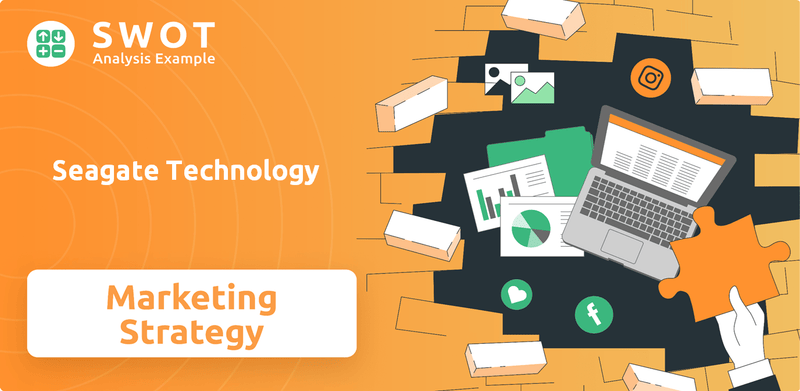
This exploration delves into Seagate's dynamic sales and marketing approach, examining how it secures its substantial Seagate market share. We'll dissect its Seagate marketing strategy, from its early OEM partnerships to its current focus on data centers, and analyze the impact of its recent marketing campaigns. The analysis will also cover Seagate's product portfolio and how it competes in the market, providing insights into its future sales and marketing plans.
How Does Seagate Technology Reach Its Customers?
The sales channels of the company, a leading data storage solutions provider, are multifaceted, integrating both online and offline strategies to cater to a diverse customer base. The company's approach involves a blend of direct and indirect sales models, ensuring broad market coverage and customer accessibility. This strategy is crucial for maintaining its market position and driving revenue growth.
Historically, the company's primary sales channel was through original equipment manufacturers (OEMs), supplying hard drives directly to PC manufacturers. This remains a significant channel, particularly for its enterprise-grade storage solutions where direct sales teams engage with large data centers and cloud service providers. The company also leverages a robust network of wholesale distributors, such as Ingram Micro and Tech Data, which then supply to a broad array of resellers and system integrators.
In the consumer and small business segments, the company has expanded its reach through e-commerce platforms, including its own company website, which offers direct-to-consumer sales. Additionally, the company's products are widely available through major online retailers like Amazon, Newegg, and Best Buy, as well as physical retail locations of electronics stores globally. The evolution of these channels has seen a strategic shift towards digital adoption and omnichannel integration, particularly for its consumer-focused products.
The company continues to partner with major PC manufacturers, providing a stable revenue stream. These partnerships are crucial for supplying hard drives and SSDs directly to the source. This channel is particularly important for enterprise-grade storage solutions, where direct sales teams engage with large data centers.
A robust network of distributors, such as Ingram Micro and Tech Data, ensures broad market coverage. These distributors supply products to a wide array of resellers and system integrators. This indirect sales channel is vital for reaching a diverse customer base.
The company has expanded its reach through e-commerce platforms, including its own website. Products are also available through major online retailers like Amazon and Newegg. This direct-to-consumer approach allows for greater control over the customer experience.
Physical retail locations of electronics stores globally provide another avenue for sales. These partnerships ensure product availability and visibility. This channel is important for customers who prefer to see and touch products before purchasing.
The company has strategically shifted towards digital adoption and omnichannel integration, particularly for its consumer-focused products. For instance, the increasing demand for external hard drives and SSDs for gaming and content creation has led the company to strengthen its partnerships with online gaming communities and content creator platforms. Strategic shifts have also included a greater emphasis on solutions-based selling, where the company works closely with partners to provide integrated storage solutions rather than just individual components.
- Emphasis on solutions-based selling to provide integrated storage solutions.
- Strengthened partnerships with online gaming communities and content creator platforms.
- Continued investment in both direct and indirect sales channels.
- Strong online presence to support direct-to-consumer sales.
Seagate Technology SWOT Analysis
- Complete SWOT Breakdown
- Fully Customizable
- Editable in Excel & Word
- Professional Formatting
- Investor-Ready Format
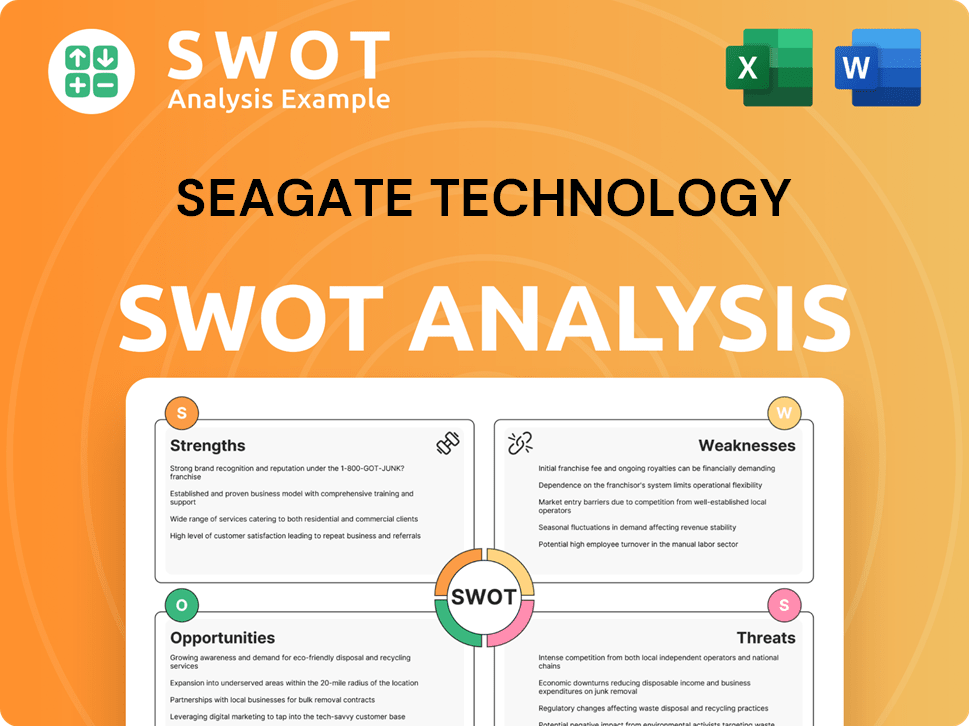
What Marketing Tactics Does Seagate Technology Use?
The company's marketing strategy is a multifaceted approach, combining digital and traditional methods to boost brand awareness, generate leads, and drive sales across its wide range of products. This strategy focuses on reaching various customer segments, from individual consumers to large enterprise clients, with tailored messaging and engagement tactics. The company's sales and marketing approach is designed to adapt to the evolving technological landscape and customer preferences.
The company's marketing efforts are geared towards showcasing its expertise in data storage solutions, particularly in areas like enterprise solutions, AI, and edge computing. They utilize a data-driven approach to refine their strategies, understand customer behavior, and optimize campaign performance. This involves customer segmentation and personalization to deliver relevant messaging based on industry, use case, and product interest.
The company's marketing tactics are designed to build brand awareness, generate leads, and drive sales. The company's marketing strategy is a dynamic process, continuously adapting to market changes and technological advancements to maintain a competitive edge.
The company heavily relies on digital marketing, with content marketing as a core strategy. This includes white papers, case studies, blog posts, and technical articles. The company utilizes Search Engine Optimization (SEO) to improve the visibility of its content, targeting keywords related to data storage and cybersecurity.
Paid advertising campaigns are run on search engines like Google Ads and professional social media platforms such as LinkedIn. Email marketing is used for lead nurturing, product announcements, and special offers. Social media platforms, including Twitter, LinkedIn, and YouTube, are used for brand building and sharing technical insights.
The company has historically used trade shows and industry events, such as CES and NAB Show, to showcase new products and network with partners and customers. These events remain crucial for direct engagement and demonstrating cutting-edge technologies. The company is leveraging interactive online tools for solution configuration and virtual product demonstrations.
The company uses analytics tools to track campaign performance, understand customer behavior, and refine targeting. Customer segmentation is key, enabling personalized messaging based on industry, use case, and product interest. The company's commitment to data-driven marketing is evident in its approach.
While influencer partnerships are more common in consumer electronics, the company has engaged with tech reviewers and industry analysts to amplify product launches and validate performance claims. This approach helps to build credibility and reach a wider audience. The company leverages these partnerships to enhance its marketing reach.
The marketing mix has shifted towards digital-first strategies, while maintaining a presence at key industry events for enterprise sales. This reflects the company's ability to adapt to the changing market. The company's innovative approach includes interactive online tools and virtual demonstrations.
The company's marketing strategy encompasses several key elements to effectively reach its target audience and drive sales. These elements include a strong emphasis on digital marketing, strategic partnerships, and data-driven decision-making. The company's approach is designed to maximize its impact in the competitive data storage market.
- Content Marketing: The company creates a variety of content, including white papers, case studies, and technical articles, to establish itself as a thought leader in the data storage industry.
- SEO and Paid Advertising: SEO is used to ensure high visibility of content, while paid advertising campaigns on platforms like Google Ads and LinkedIn target IT professionals and business decision-makers.
- Email Marketing: Email campaigns are used for lead nurturing, product announcements, and exclusive offers.
- Social Media Engagement: The company uses social media platforms like Twitter, LinkedIn, and YouTube for brand building, community engagement, and sharing technical insights.
- Industry Events: Trade shows and industry events remain important for showcasing new products and networking.
- Data Analytics: The company uses analytics tools to track campaign performance, understand customer behavior, and refine targeting, ensuring a data-driven approach.
- Customer Segmentation: The company segments its customer base to deliver personalized messaging based on industry, use case, and product interest.
Seagate Technology PESTLE Analysis
- Covers All 6 PESTLE Categories
- No Research Needed – Save Hours of Work
- Built by Experts, Trusted by Consultants
- Instant Download, Ready to Use
- 100% Editable, Fully Customizable
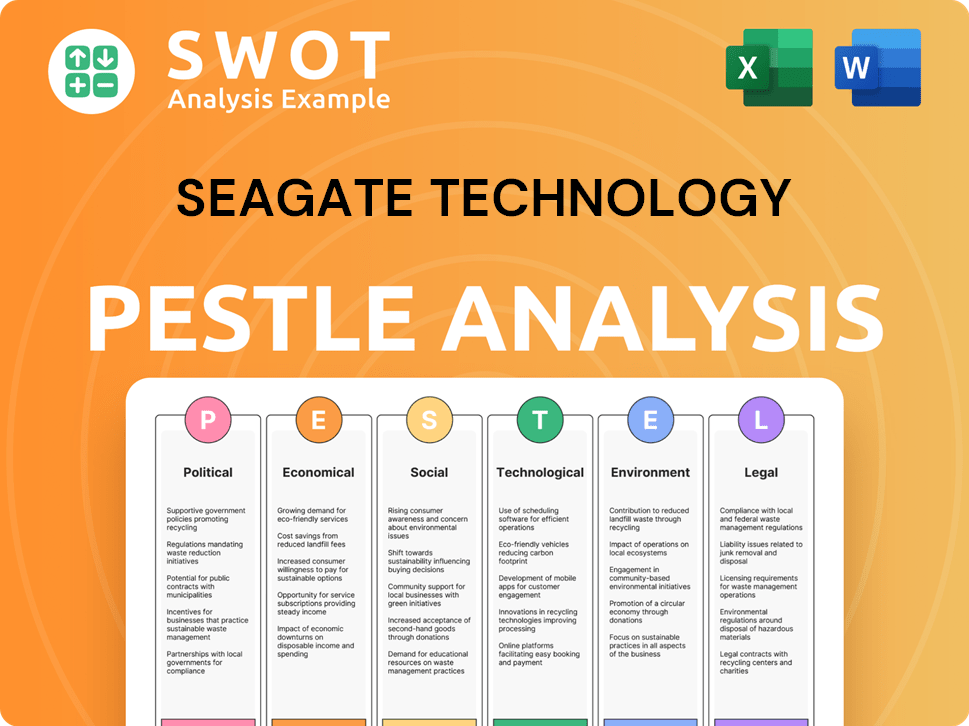
How Is Seagate Technology Positioned in the Market?
The brand positioning of the company focuses on being a leader in mass-capacity data storage. It emphasizes reliability, performance, and innovation. The core message revolves around 'data at the heart of human experience,' underscoring the critical role its storage solutions play in enabling everything from personal memories to global enterprise operations.
Visually, the brand identity incorporates clean lines and technological aesthetics, conveying precision and advanced engineering. Its tone of voice is authoritative and knowledgeable, reflecting its deep expertise in the data storage industry, while also being accessible to a broad range of technical and non-technical audiences. The customer experience it promises is one of seamless data management, security, and accessibility.
The company appeals to its target audience by focusing on innovation and meeting the escalating demands for data storage. Its unique selling proposition lies in its extensive research and development capabilities, leading to breakthroughs in storage density, speed, and durability. For instance, the company continues to push the boundaries of hard drive capacity, with recent announcements of 30TB+ drives in 2024, demonstrating its commitment to meeting the insatiable demand for data storage. In a competitive landscape, the company differentiates itself by offering a comprehensive portfolio that caters to a wide spectrum of storage needs, from consumer-grade external drives to highly specialized enterprise storage arrays.
The company consistently ranks among the top global hard drive manufacturers. This is a testament to its strong brand equity and market acceptance. While specific brand perception data is often proprietary, its position reflects its significant presence in the data storage market.
The company invests heavily in research and development to maintain its competitive edge. This focus on innovation leads to breakthroughs in storage density and performance. This is a key factor in its marketing strategy.
The company offers a diverse product portfolio, catering to various market segments. This includes consumer-grade external drives and enterprise storage solutions. This wide range allows it to target different customer needs effectively.
Brand consistency is maintained across all channels and touchpoints, from product packaging to its corporate website and social media presence. This ensures a cohesive brand image and message. This is an important aspect of the company’s Revenue Streams & Business Model of Seagate Technology.
The company's target audience includes individual consumers, small businesses, and hyperscale data centers. Its marketing strategies are tailored to meet the specific needs of each segment. This ensures effective communication and product positioning.
Key competitive advantages include its extensive R&D capabilities and comprehensive product portfolio. These factors enable it to meet diverse storage needs. This helps the company maintain its position in the market.
The company actively responds to shifts in consumer sentiment, particularly concerning data privacy and sustainability. It highlights its secure data solutions and efforts towards environmentally responsible manufacturing. This is a part of its marketing strategy.
The company utilizes various marketing campaigns to promote its products and brand. These campaigns often focus on innovation, performance, and reliability. These campaigns are designed to reach its target audience effectively.
The company employs a robust digital marketing strategy, including social media and content marketing. This helps to engage with customers and build brand awareness. This strategy is crucial for reaching a wide audience.
The company's pricing strategy is competitive and aligned with its product offerings. Pricing is based on factors like storage capacity, performance, and target market. This strategy is designed to maximize sales and profitability.
Seagate Technology Business Model Canvas
- Complete 9-Block Business Model Canvas
- Effortlessly Communicate Your Business Strategy
- Investor-Ready BMC Format
- 100% Editable and Customizable
- Clear and Structured Layout
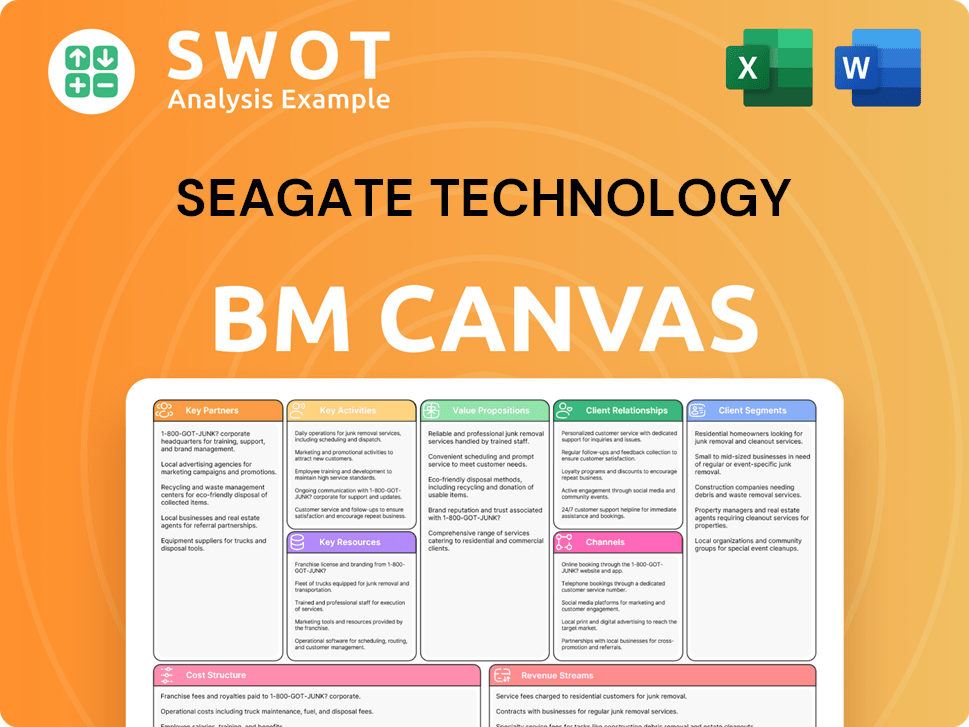
What Are Seagate Technology’s Most Notable Campaigns?
The sales and marketing strategies of Seagate Technology have evolved significantly, mirroring changes in the data storage industry. The company has consistently adapted its approach to meet the demands of various market segments, from individual consumers to large enterprise clients. These strategies are critical for maintaining and expanding its market share in a competitive landscape. Understanding these campaigns provides insights into how Owners & Shareholders of Seagate Technology can assess the company's performance and strategic direction.
Seagate's marketing efforts are designed to build brand awareness, drive product adoption, and establish strong customer relationships. The company employs a multi-channel approach, utilizing print and digital advertising, partnerships, and content marketing. These campaigns are often tailored to specific product lines and target audiences, ensuring effective communication and engagement. The success of these efforts is reflected in its continued leadership in the hard disk drive (HDD) market.
Seagate's sales strategy focuses on both direct sales and channel partnerships. The company leverages its extensive distribution network to reach a global customer base. Key accounts are managed directly by sales teams, while smaller customers are served through distributors and resellers. This approach allows Seagate to maximize its market reach and cater to diverse customer needs. The company's sales performance is closely tied to its ability to innovate and deliver high-quality storage solutions.
This campaign focused on the 'Barracuda' series of internal hard drives. It aimed to position the product as the preferred choice for PC builders and enthusiasts. The campaign utilized print ads in tech magazines, online banners, and partnerships with retailers. While specific sales data isn't available, this line helped Seagate gain a significant market share in the PC segment.
This ongoing campaign highlights enterprise storage solutions. The goal is to establish as a key partner for hyperscale data centers and cloud service providers. It features visuals of vast data landscapes and emphasizes scalability and efficiency. Key channels include industry trade shows, digital advertising, and thought leadership content. This campaign supports the company's continued leadership in nearline HDD shipments.
Seagate has collaborated with gaming influencers to promote its FireCuda gaming drives. This strategy boosts visibility and credibility within the gaming community. These collaborations are part of the company's broader marketing efforts to reach specific consumer segments. This approach has helped drive sales within the gaming sector.
Targeted at IT decision-makers, these campaigns focus on enterprise storage solutions. They involve direct engagement, webinars, and whitepapers. The aim is to generate leads and secure large-scale contracts. These efforts are crucial for maintaining market share in the enterprise storage segment. These campaigns are designed to support the company's enterprise sales teams.
The evolution of Seagate's sales and marketing strategies reflects its adaptation to the changing data storage landscape. These campaigns are essential for maintaining and expanding its market presence. The company's ability to innovate and target specific market segments is key to its success. These strategies are designed to drive product adoption and establish strong customer relationships.
- Focus on enterprise solutions and mass capacity storage.
- Use of digital advertising, industry trade shows, and thought leadership.
- Partnerships with gaming influencers to boost visibility.
- Continued focus on product innovation and quality.
Seagate Technology Porter's Five Forces Analysis
- Covers All 5 Competitive Forces in Detail
- Structured for Consultants, Students, and Founders
- 100% Editable in Microsoft Word & Excel
- Instant Digital Download – Use Immediately
- Compatible with Mac & PC – Fully Unlocked
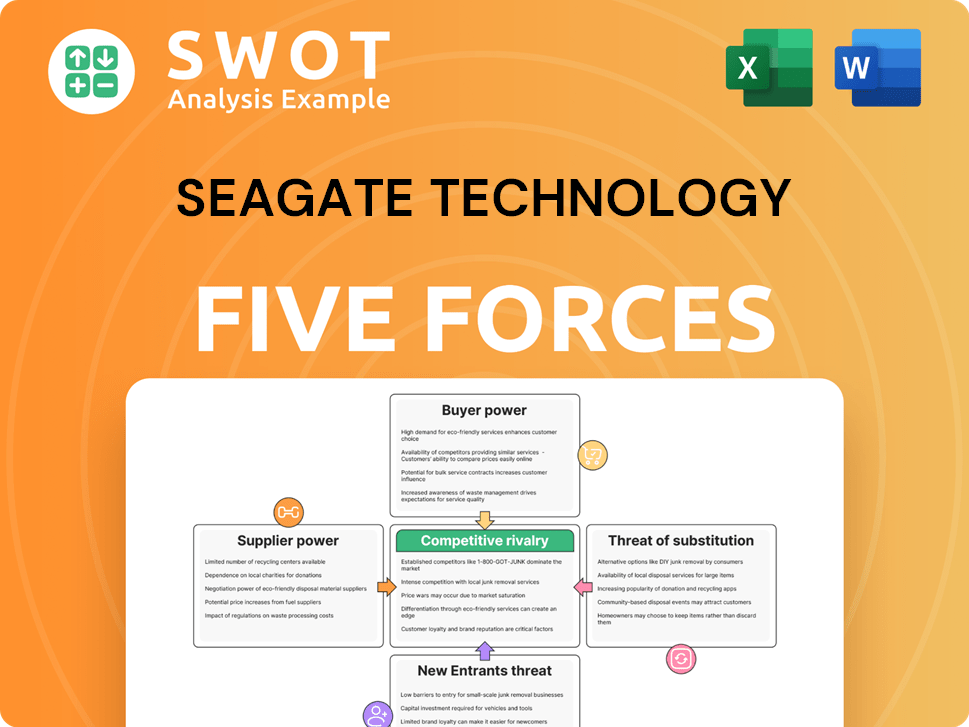
Related Blogs
- What are Mission Vision & Core Values of Seagate Technology Company?
- What is Competitive Landscape of Seagate Technology Company?
- What is Growth Strategy and Future Prospects of Seagate Technology Company?
- How Does Seagate Technology Company Work?
- What is Brief History of Seagate Technology Company?
- Who Owns Seagate Technology Company?
- What is Customer Demographics and Target Market of Seagate Technology Company?
Disclaimer
All information, articles, and product details provided on this website are for general informational and educational purposes only. We do not claim any ownership over, nor do we intend to infringe upon, any trademarks, copyrights, logos, brand names, or other intellectual property mentioned or depicted on this site. Such intellectual property remains the property of its respective owners, and any references here are made solely for identification or informational purposes, without implying any affiliation, endorsement, or partnership.
We make no representations or warranties, express or implied, regarding the accuracy, completeness, or suitability of any content or products presented. Nothing on this website should be construed as legal, tax, investment, financial, medical, or other professional advice. In addition, no part of this site—including articles or product references—constitutes a solicitation, recommendation, endorsement, advertisement, or offer to buy or sell any securities, franchises, or other financial instruments, particularly in jurisdictions where such activity would be unlawful.
All content is of a general nature and may not address the specific circumstances of any individual or entity. It is not a substitute for professional advice or services. Any actions you take based on the information provided here are strictly at your own risk. You accept full responsibility for any decisions or outcomes arising from your use of this website and agree to release us from any liability in connection with your use of, or reliance upon, the content or products found herein.